What The Tom’s Team Played This Weekend: PC Building Simulator
Twenty years ago, gaming is what got me excited about PC hardware. Hacking up the Celeron 300A was a means to an end; I wanted Quake II to run better, of course! But these days, it’s rare that I can carve out two or three hours to progress through new content. Don’t get me wrong—I still love gaming. But I typically only play far enough through them to decide if they belong in our GPU benchmark suite. For those that make the cut, I end up watching the same test sequence 30 or 40 times per graphics-card review.
It seems odd, then, that I’d spend a weekend playing something called PC Building Simulator. After all, building PCs is already part of my job. And if I really want to build something, the lab is full of loose components.
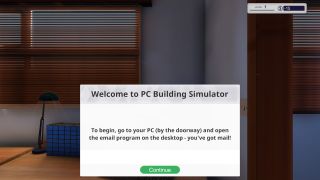
But in a world where even Tom’s Hardware editors have a hard time sourcing graphics cards to test, it only made sense to ride out the ongoing shortage with a game that doesn’t ask much of my aging Core i7-3770K-based workstation and still thinks that GeForce GTX 1050 Ti cards cost $150. Besides, my wife is busy managing a farm on her phone and my son is running some kind of baby dragon mill. A PC-building simulator isn’t the most far-fetched work-like game being played around here. So, let’s give it a shot…
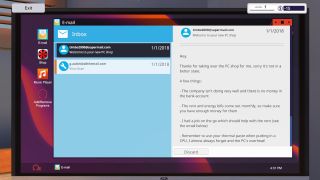
Well, this isn’t good. I paid $20 on Steam to build PCs without wearing an anti-static wrist strap or having to battle pre-production firmware, not to turn around a failing business. However, Career mode (one of three ways to play PC Building Simulator) starts you off with an empty bank account, impending bills, and a fairly dissatisfied clientele. The electric company even nags you to turn the lights out when you leave for the day. Ugh, thanks Uncle Tim! Fortunately, your first customer lobs over a softball: remove viruses for $100.

From there, the game does a good job of introducing you to its controls. A PC is picked up from your lobby, brought back to the workbench, plugged in, and booted up. Sometimes your only job is to install software from a USB thumb drive and run 3DMark. Other requests involve swapping motherboards, upgrading storage, or replacing damaged CPUs.
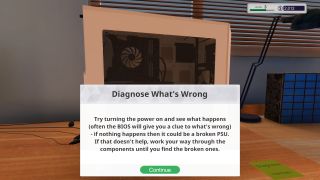
The first round of customers all seem to know what they need. Later tasks, however, require troubleshooting. That means you can’t order parts until you’ve had a chance to open the PC up and determine its issue. To start, obvious clues like “No CPU Found” during POST narrow the focus considerably. Then, as you progress through work orders, the hints become increasingly vague, forcing you to pick and choose the parts to swap based on educated guesses. Leveling up gives you access to new hardware in the store, second and third workbenches, and time-saving tools.
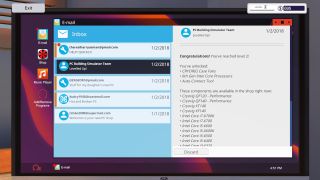
PC Building Simulator even tests your morality. At first, every customer received new hardware from the online store. I quickly tired of paying $30 for next-day shipping, though, and discovered I could use a previous customer’s old hardware for finishing a new task, rather than waiting three to five days for standard freight. As shady as that sounds, some folks go further, claiming they’re able to under-deliver on upgrades and still collect payment for completed jobs. It'd be great to see a future build of the simulator incorporate checks for this behavior. Customers could check the S.M.A.R.T. data on their hard drives, for example, to determine if you dropped in a used one.
Stay on the Cutting Edge
Join the experts who read Tom's Hardware for the inside track on enthusiast PC tech news — and have for over 25 years. We'll send breaking news and in-depth reviews of CPUs, GPUs, AI, maker hardware and more straight to your inbox.


At a certain point, you will want to step away from PC Building Simulator. This isn't a game you're going to binge on. Music in the Early Access build is limited to a handful of tracks, and there’s no way pipe in your own jams. Beyond that, certain repairs are simply more arduous than others, just like in real life. Dead motherboard requiring the replacement of all nine stand-offs? Sure, I’ll hold the mouse down over each one, and then do it again to screw them back in…but I’m not going to like it.

Still, I inevitably found myself coming back to PC Building Simulator several times over the weekend, if only to knock out a few more orders before getting sick of abbreviated 3DMark runs or the same couple of songs.
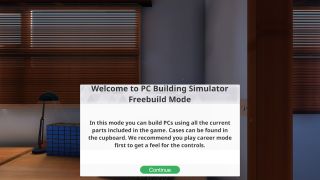
The Free Build mode doesn’t have much replay value, and I’m not sure I’d trust the How To Build A PC mode as a training tool (clicking parts on a computer screen just isn’t the same). But Career mode is legitimately fun in brief sessions. Each component is modeled in excellent detail, and a simple user interface makes it easy to zip around the shop.

We’d love to see Claudiu Kiss incorporate an option for importing music. Currently, the developer’s public roadmap suggests an expanded soundtrack will be added before exiting Early Access, but I’d like to create my own playlist. It also looks like more career content is planned, along with support for water cooling, modding, overclocking, and cable management. All of those would go a long way in making the simulated build process more realistic.
A lot of enthusiasts are chomping at the bit for a chance to upgrade real gaming PCs. But graphics cards and high-end power supplies are still marked way up. A game like this may keep those folks distracted just long enough for prices to slide down a bit.

Fun fact: Seth Colaner and I both contributed to the issue of Computer Power User magazine hanging in the virtual workshop.
-
MCMunroe I co-teach a Student Tech Team at a High School and we are looking at getting a copy to let kids mock build PCs and get a taste of using tech skills and trouble shooting.Reply -
10tacle "Twenty years ago, gaming is what got me excited about PC hardware. Hacking up the Celeron 300A was a means to an end; I wanted Quake II to run better"Reply
LOL Chris I could have written that line myself. EXACTLY. My first build in 1998 was the Celery 300 overclocked to ~400MHz running a Riva TNT GPU pushing a Dell 17" Trinitron 1280x1024 CRT. I don't remember the memory but the HDD was a whopping 4.3GB, which I still have, and yes it still works (Western Digital made in Malaysia). All for Quake II and Half Life 1. I never looked back since.
20849844 said:lol. This is a thing?
Uhm, yeah. It may sound silly but as stated above, there is a use for this to introduce people/students into the world of building a PC. Just like flight simulators for aspiring pilots. I might get this myself and I've been building PCs for 20 years. -
XboxCarsForza I was able to swap a gigabyte 1050ti 4GB for an r9 380 2GB. Was counted as an upgrade.Reply -
James Mason If farm simulators and truck simulators can get yearly releases, this isn't really too far fetchedReply -
10tacle Reply20851142 said:If farm simulators and truck simulators can get yearly releases, this isn't really too far fetched
I don't have Farm Simulator but I do have ETS2 and ATS. It's a sleeper in addiction. Especially with all the cool freeware add-ons available to trick your truck out, add cool AI vehicles to traffic, weather, gas station mods, etc. When I'm not in the mood to sim race and just want to chill, I just kick back in a truck and enjoy the countryside on my way to a delivery. -
John Pombrio This sounds like my old job at HP with Test and measurement gear. The game developers would need to pay me to play the game.Reply -
jimthenagual If they incorporate custom liquid loops, I'm in. I would love to do a virtual build and seeing how it all fits and looks ahead of time!Reply -
justin.m.beauvais My first thought was that I need this in VR.Reply
I think I might have a problem... -
bananatiger This is great for people that wants to build and test some PC parts but doesn't have the money to buy them in real life. Just wish that there is benchmark option and that the results are all similar to their real world counter-part. Planning to play this game.Reply
Most Popular





